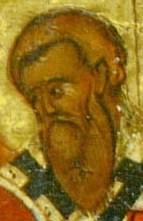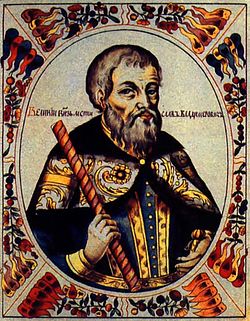Top Qs
Timeline
Chat
Perspective
April 15 (Eastern Orthodox liturgics)
From Wikipedia, the free encyclopedia
Remove ads
April 14 - Eastern Orthodox liturgical calendar - April 16

All fixed commemorations below are observed on April 28 by Eastern Orthodox Churches on the Old Calendar.[note 1]
For April 15th, Orthodox Churches on the Old Calendar commemorate the Saints listed on April 2.
Saints
- Apostles Aristarchus of Apamea,[1] Pudens,[2] and Trophimus[3] of the Seventy Apostles (c. 67)[4][5][6] (see also: April 14 - Greek)
- Martyrs Basilissa and Anastasia of Rome, disciples of Apostles Peter and Paul (c. 68)[4][6][7][8][note 2]
- Martyr Sukia (Suchias) and nineteen companions with him, including (c. 100-130):[4][6][10][11]
- Andrew, Anastasius, Thalaleus, Theodoretus, Ivchirion, Jordan, Quadratus, Lucian, Mimnenus, Nerangius, Polyeuctus, Jacob, Phocas, Domentianus, Victor, and Zosima (Chorimos), of Georgia, in Armenia.
- Hieromartyr Theodore and martyr Pausilippus of Thrace, by the sword (c. 117-138)[4][9][12]
- Martyrs Maximus and Olympiada, in Persia (c. 249-251)[13][14][note 3]
- Saint Leonidas, Bishop of Athens (250)[4][15][note 4]
- Martyr Crescens of Myra in Lycia, by fire (3rd century)[4][9][16] (see also: April 13 - Slavic)
- Martyr Sabbas the Goth, at Buzău in Wallachia (372)[4][5][6][17][note 5] (see also: April 12 - Greek and Romanian)
- Saint Ephraim the Great of Atsquri (9th century)[19][20] (see also: April 17)
Remove ads
Pre-Schism Western saints
- Martyrs Maro, Eutyches and Victorinus, at Rome, under Trajan (c. 99)[21][22][note 6]
- Martyr Eutychius, in Ferentino in Italy.[21]
- Child-martyr Laurentinus Sossius, a boy aged five, martyred on Good Friday in Valrovina near Vicenza in Italy (485)[21]
- Saint Paternus (Paternus of Vannes, Padarn), Bishop and founder of the monastery of Llanbadarn Fawr (the great monastery of Padarn) near Aberystwyth in Wales (565)[5][21][23][24][25][note 7] (see also: April 16)
- Saint Ruadhan (Ruadan, Rodan), one of the leading disciples of St Finian of Clonard, founder and abbot of Lothra, Ireland (c. 584)[4][5][21][27][28]
- Saint Silvester, second Abbot of Moutier-Saint-Jean (Réome) near Dijon in France (c. 625)[21]
- Saint Hunna, the self-sacrificing wife of a nobleman in Alsace, now in France (679)[21]
- Saint Nidger (Nidgar, Nitgar), Abbot of Ottobeuren Abbey in Bavaria, became Bishop of Augsburg in Germany (c. 829)[21]
- Saint Mundus (Munde, Mund, Mond), an abbot who founded several monasteries in Argyll in Scotland (c. 962)[21]
Remove ads
Post-Schism Orthodox saints
- Saint Mstislav-Theodore, Prince of Kiev (1132)[4][5][29][note 8]
- Venerable Basil of Moldovita, Igumen of Moldovița Monastery and Wonderworker (ca. 1455)[30][31][note 9]
- Venerable Dionysius of Pereyaslavl-Zalessky, monk of the Nikitsky Monastery (1645)[32][33][note 10]
- Hieromartyr Ananias (Lambardis) of Lacedaemonia, Metropolitan Bishop of Lacedaemonia (1764)[34][note 11]
- Basil of Poiana Mărului (1767)[5][35]
- Righteous Daniel of Achinsk, Siberia (1843)[4][5][note 12]
New martyrs and confessors
Other commemorations
- Repose of Hieroschemamonk Michael (Pitkevich) of Valaam and Pskov Caves, the last Elder of Valaam (1962)[4]
- Repose of Bishop Stephen (Nikitin) of Kaluga (1963)[4]
Icon gallery
- St. Aristarchus of Thessalonica (Aristarchus of Apamea).
- St. Pudens.
- Martyrs Basilissa and Anastasia of Rome (Menologion of Basil II).
- St. Leonidas, Bishop of Athens.
- St. Paternus.
- Lorrha Priory of St. Ruadhan.
- Saint Mstislav-Theodore, Prince of Kiev.
- Righteous Daniel of Achinsk.
Notes
- The notation Old Style or (OS) is sometimes used to indicate a date in the Julian Calendar (which is used by churches on the "Old Calendar").
The notation New Style or (NS), indicates a date in the Revised Julian calendar (which is used by churches on the "New Calendar"). - "AT Rome, the Saints Basilissa and Anastasia. Of noble family, they were disciples of the Apostles, and as they persevered courageously in the profession of their faith in the time of the emperor Nero, they had their tongues and feet cut off, were put to the sword, and thus obtained the crown of martyrdom."[9]
- Name days celebrated today include:
- Leonidas (Λεωνίδας).
- St Sava the Goth in Bessarabia (372). Sava was martyred by pagan Goths. St Basil the Great asked for his relics, which he received, and wrote a panegyric in St Sava’s honour. He is especially venerated throughout Bessarabia, Moldavia, Wallachia and Romania.[18]
- "The same day, the holy martyrs Maro, Eutyches, and Victorinus, who, with blessed Flavia Domitilla, were banished to the island of Pontia (Ponza) for the confession of Christ. Being recalled in the reign of Nerva, and having converted many to the faith, they were put to death in different manners by the judge Valerian during the persecution of Trajan."[9]
- "Several Saints bear the name of Paternus. The one commemorated to-day was intimately connected with Great Britain, though a native of Brittany, and the son of a holy man called Petran, who had quitted his family and his country to embrace the religious state in Ireland. St. Padarn also forsook his home with the intention of joining his father; but, by the order of Providence, he landed in Wales, and there found an ample field for the exercise of his zeal in God's service. He established the great Abbey of Llanbadarn Vaur, which is said to have been the seat of his bishopric, and, according to the tradition, built other monasteries and churches. He was indefatigable in preaching the Faith, consoling the sick and afflicted, and ministering to the poor, while he was incessantly devoted to prayer and holy austerity of life. By such virtues he earned the title of one of the Blessed Visitors of Britain. According to the account received in Brittany, St. Padarn, after completing his work in Wales, returned to his native country, and there reposed in the Lord."[26]
- See: (in Greek) Ανανίας Λαμπάρδης μητροπολίτης Λακεδαιμονίας. Βικιπαίδεια. (Greek Wikipedia).
- See: (in Russian) Даниил Ачинский. Википедии. (Russian Wikipedia).
Remove ads
References
Sources
Wikiwand - on
Seamless Wikipedia browsing. On steroids.
Remove ads








